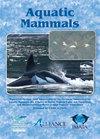Arabian Sea Humpback Whale (Megaptera novaeangliae) Singing Activity off Netrani Island, India
IF 0.9
4区 生物学
Q4 MARINE & FRESHWATER BIOLOGY
引用次数: 0
Abstract
Arabian Sea humpback whales (Megaptera novaeangliae), listed as “Endangered” on the International Union for Conservation of Nature’s Red List, remain resident throughout the year in the waters of the Arabian Sea and constitute a genetically isolated population. In the eastern Arabian Sea, information on humpback whales off the Indian coast has largely been limited to stranding records, local ecological knowledge, and opportunistic visual sighting data. These data, along with information from a long-term study off Oman, suggest that humpback whales migrate across the Arabian Sea into Indian territorial waters from October to March. To study the presence of Arabian Sea humpback whales in Indian waters more comprehensively, passive acoustic monitoring (PAM) was initiated along the west coast of India in 2019. Male humpback whales produce complex songs with a stereotyped structure; these songs are shared within a population, and song patterns are known to evolve progressively over time. In this article, a structural analysis of humpback whale song recorded over four days off the coast of Netrani Island, Karnataka, India, in December 2019 is presented. Time-frequency features of 2,641 individual call units were analysed. Call units had a fundamental frequency bandwidth ranging from 149.98 to 541.65 Hz, with a duration ranging from 1.19 to 5.5 s. The call units were used to identify phrases and themes required to construct the structure of the song, which can potentially help identify the population to which singing individuals belong. This study indicates the need for a long-term PAM program across the Arabian Sea to compare whale songs across the region. Simultaneous recordings over multiple seasons will best assess population connectivity, seasonal occurrence, and movement patterns within and between populations across the Arabian Sea and the Indian Ocean.印度内特拉尼岛附近的阿拉伯海座头鲸歌唱活动
阿拉伯海座头鲸(Megaptera novaeangliae)被国际自然保护联盟(International Union for Conservation of Nature)的红色名录列为“濒危”物种,常年居住在阿拉伯海水域,是一个基因孤立的种群。在阿拉伯海东部,关于印度海岸座头鲸的信息在很大程度上仅限于搁浅记录、当地生态知识和机会视觉观测数据。这些数据,以及阿曼海域一项长期研究的信息表明,座头鲸在10月至3月期间穿越阿拉伯海迁移到印度领海。为了更全面地研究阿拉伯海座头鲸在印度水域的存在,2019年在印度西海岸启动了被动声学监测(PAM)。雄性座头鲸会发出结构刻板的复杂歌声;这些歌曲在一个群体中是共享的,并且已知歌曲模式会随着时间的推移而逐渐演变。本文对2019年12月在印度卡纳塔克邦Netrani岛海岸四天内记录的座头鲸歌声进行了结构分析。分析了2641个单独呼叫单元的时频特征。呼叫单元的基频带宽在149.98到541.65赫兹之间,持续时间在1.19到5.5秒之间。呼叫单元用于识别构建歌曲结构所需的短语和主题,这可能有助于识别唱歌个体所属的群体。这项研究表明,需要在阿拉伯海开展一项长期的PAM计划,以比较该地区的鲸鱼歌声。多个季节的同时记录将最好地评估阿拉伯海和印度洋人口的连通性、季节性发生以及人口内部和之间的流动模式。
本文章由计算机程序翻译,如有差异,请以英文原文为准。
求助全文
约1分钟内获得全文
求助全文
来源期刊

Aquatic Mammals
MARINE & FRESHWATER BIOLOGY-ZOOLOGY
CiteScore
1.60
自引率
16.70%
发文量
99
审稿时长
>12 weeks
期刊介绍:
Aquatic Mammals is a peer-reviewed journal sponsored by the European Association for Aquatic Mammals (EAAM), the Alliance of Marine Mammal Parks and Aquariums (AMMPA), and the International Marine Animal Trainers’ Association (IMATA). Aquatic Mammals publishes articles related to marine mammals (whales, dolphins, seals, fur seals, sea lions, walrus, dugongs, manatees, sea otters, and polar bears). Topics of publication on both captive animals and wild marine mammals include aspects of husbandry; behavior; conservation; veterinary medicine; anatomy; physiology; training; population trends; and the effects of pollution, climate change, and noise.
 求助内容:
求助内容: 应助结果提醒方式:
应助结果提醒方式:


